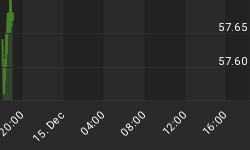Simple Support And Resistance
Thursday's new all-time closing high on the S&P 500 is relevant from a support and resistance perspective. The previous all-time closing high of 1,848 was printed January 15.

Between January 15 and February 26 the S&P 500 was unable to surpass 1,848 on a closing basis, which established 1,848 as resistance. From stockcharts.com:
Support and resistance represent key junctures where the forces of supply and demand meet. Resistance is the price level at which selling is thought to be strong enough to prevent the price from rising further. The logic dictates that as the price advances towards resistance, sellers become more inclined to sell and buyers become less inclined to buy. By the time the price reaches the resistance level, it is believed that supply will overcome demand and prevent the price from rising above resistance. Resistance does not always hold and a break above resistance signals that the bulls have won out over the bears. A break above resistance shows a new willingness to buy and/or a lack of incentive to sell. Resistance breaks and new highs indicate buyers have increased their expectations and are willing to buy at even higher prices.
The expression "what once was resistance now becomes support" tells us 1,848 could now establish itself as a level where buyers are more likely to step in. The S&P 500 closed at 1,854 Thursday.
Could Weak Data Bring A Taper Pause?

Since the Federal Reserve does not have a formal meeting scheduled until March 18, the market's perception of what the Fed may do, right, wrong, or indifferent, is what is important over the next three weeks. Thursday's report on employment may increase the perception of a possible Fed pause relative to their tapering schedule. From Bloomberg:
More Americans than forecast filed applications for unemployment benefits last week, a sign the labor market is improving in fits and starts. Jobless claims increased by 14,000 to 348,000 in the week ended Feb. 22, exceeding all forecasts in a Bloomberg survey and the highest level in a month, from 334,000 in the prior period, a Labor Department report showed today in Washington. A Labor Department spokesman said no states were estimated and there was nothing unusual in the data.
Plunge Conditions No Longer Exist
We noted February 11 that it was not worth losing too much sleep over the 1929 stock market crash parallel unless the S&P 500 dropped below 1,737. The market's lowest intraday level since then was 1,800, or nowhere near 1,737. Bloomberg provided some additional insight into the 1929 parallel this week:
After predicting the sell-off that began in January had the potential to snowball into a full-blown crash, Tom DeMark, the founder of DeMark Analytics LLC, is sounding the all-clear. DeMark said in a Feb. 5 interview on CNBC that the U.S. stock market had reached an "inflection point" and the S&P 500 could fall to 1,100 if certain conditions over the next few days were met. The price patterns he was watching for didn't emerge, and by Feb. 6 DeMark knew the market wouldn't plunge, he said in a Feb. 24 phone interview. The S&P 500 will probably rise to about 1,885 within the next three weeks after about six successively higher closes, DeMark said. That implies a gain of more than 2 percent. "It was just something novel to look at," DeMark said of his earlier statement about the possibility of a crash. "The short-term requirements in early February had to exist, and they didn't exist, and they expired."
Investment Implications - Still Long, But Friday Is Big Day
As we noted February 26, hesitation in isolation is not bearish:
The hesitant nature of the markets has not morphed into a meaningful change in the demand for defensive assets relative to growth-oriented assets. Consequently, we continue to maintain exposure to U.S. stocks (SPY), and technology stocks (QQQ). The market's recent hesitation near all-time highs is accounted for in our market model by maintaining exposure to bonds (TLT) and cash.
The comments above still apply; we made no allocation changes Thursday. However, the tweet below says Friday could set the tone for the week.

Should the market sell off after the slew of economic data Friday, the chart below highlights some levels below 1,848 that we will be keeping an eye on. The evidence in hand has, and continues to support, an allocation with a risk-on bias. Some buying above 1,850 would put that stance on even firmer footing.
















